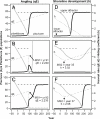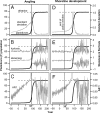Turning back from the brink: detecting an impending regime shift in time to avert it
- PMID: 19124774
- PMCID: PMC2630060
- DOI: 10.1073/pnas.0811729106
Turning back from the brink: detecting an impending regime shift in time to avert it
Abstract
Ecological regime shifts are large, abrupt, long-lasting changes in ecosystems that often have considerable impacts on human economies and societies. Avoiding unintentional regime shifts is widely regarded as desirable, but prediction of ecological regime shifts is notoriously difficult. Recent research indicates that changes in ecological time series (e.g., increased variability and autocorrelation) could potentially serve as early warning indicators of impending shifts. A critical question, however, is whether such indicators provide sufficient warning to adapt management to avert regime shifts. We examine this question using a fisheries model, with regime shifts driven by angling (amenable to rapid reduction) or shoreline development (only gradual restoration is possible). The model represents key features of a broad class of ecological regime shifts. We find that if drivers can only be manipulated gradually management action is needed substantially before a regime shift to avert it; if drivers can be rapidly altered aversive action may be delayed until a shift is underway. Large increases in the indicators only occur once a regime shift is initiated, often too late for management to avert a shift. To improve usefulness in averting regime shifts, we suggest that research focus on defining critical indicator levels rather than detecting change in the indicators. Ideally, critical indicator levels should be related to switches in ecosystem attractors; we present a new spectral density ratio indicator to this end. Averting ecological regime shifts is also dependent on developing policy processes that enable society to respond more rapidly to information about impending regime shifts.
Conflict of interest statement
The authors declare no conflict of interest.
Figures





References
-
- Scheffer M, Carpenter SR, Foley JA, Folke C, Walker BH. Catastrophic shifts in ecosystems. Nature. 2001;413:591–596. - PubMed
-
- Carpenter SR. Regime Shifts in Lake Ecosystems: Pattern and Variation. Oldendorf, Germany: International Ecology Institute; 2003.
-
- MA. Ecosystems and Human Well-Being: Synthesis. Washington DC: Island; 2005.
-
- IPCC. Climate Change 2007: Synthesis Report. Geneva: IPCC; 2007.
-
- Steffen WL, et al. Global Change and the Earth System: A Planet Under Pressure. Berlin, Germany: Springer; 2004.
Publication types
MeSH terms
LinkOut - more resources
Full Text Sources
Other Literature Sources

